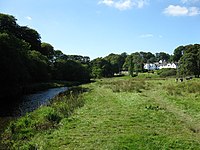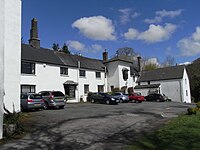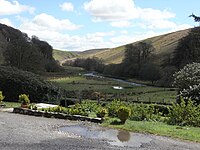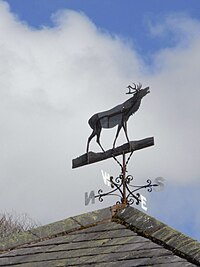Simonsbath
| Simonsbath | |
|---|---|
Location within Somerset | |
| Area | 82.07 km2 (31.69 sq mi) |
| Population | 156 |
| • Density | 2/km2 (5.2/sq mi) |
| OS grid reference | SS775395 |
| Civil parish |
|
| District | |
| Shire county | |
| Region | |
| Country | England |
| Sovereign state | United Kingdom |
| Post town | Minehead |
| Postcode district | TA24 |
| Police | Avon and Somerset |
| Fire | Devon and Somerset |
| Ambulance | South Western |
| UK Parliament | |


Simonsbath (/ˈsɪmənzbɑːθ, -bæθ/) is a small village high on Exmoor in the English county of Somerset. It is the principal settlement in the Exmoor civil parish, which is the largest and most sparsely populated civil parish on Exmoor, covering nearly 32 square miles (83 km2) but with a population, at the time of the 2001 census, of 203 in 78 households,[2] reducing to 156 at the 2011 census.[3] The River Exe rises from a valley to the north, and the River Barle runs through the village and is crossed by a triple-arched medieval bridge that was extensively repaired after floods in 1952.[4]
The settlement lies on the route of the Two Moors Way and close to the Macmillan Way West.
Toponymy
The -bath element in this place-name, not recorded before 1791,[5] is easily accounted for: the Old English bæth signified "water, a pool". The identity of Simon is less sure. R. J. King pointed out that the name is frequently met with in the West of England, "especially in connection with old boundary lines".[6] Thomas Westcote, in his View of Devonshire in 1630, preserved a local tradition that "Simon" was a great hunter and Robin Hood-like figure who had his stronghold at Symonsburrow, at the highest point of the Blackdown Hills, a barrow that pre-dates even a medieval legend associated with it.
History
Simonsbath House

Simonsbath House was built in 1654[7] by the merchant, lawyer and philosopher James Boevey (1622–1696), the warden of the Royal forest of Exmoor, and for 150 years his was the only house in the forest, which consists largely of moorland. The Grade II listed building is now the Simonsbath House Hotel[8] and outdoor activity centre.[9]
Sale by the King

On 4 July 1815 an Act of Parliament (55 Geo. 3. c. 138) was passed to enable the Inclosure of Exmoor, the summary heading of which was: "An Act for vesting in His Majesty certain parts of the Forest of Exmoor otherwise Exmore in the counties of Somerset and Devon and for enclosing the said Forest".[10] After the Forest had been split into allotments and these had been conveyed to the persons who formerly possessed rights over the Forest, 12⁄22nds of the whole remained the property of the King,[11] which equated to 10,262 1⁄4 acres, and was formally allotted to him as his personal property in the same way as the other shares went to the traditional graziers and owner of the tithes (Sir Thomas Dyke Acland, 10th Baronet (1787–1871), of Holnicote, who received 1⁄8th of the total[12]), etc. In 1818 the following sales particulars were published by HM Commissioners of Woods, Forests and Land Revenues:[13]
"Particulars of a freehold farm belonging to His Majesty and of the allotments (tithe free) made to His Majesty on the Inclosure of Exmoor Forest in the counties of Somerset and Devon to be sold by public tender on 23d day of July 1818, viz. the farm called Simon's Bath Farm situated within the said forest (which farm is enclosed & separated from the unenclosed land) containing by estimation 108 a(cres) 2 r(ods) 0 p(erches) & these several allotments of waste land situated in the center of the said forest contiguous & adjoining to each other and to the farm above mentioned & numbered on the map 32, 33, 34, 35, 36, 37, 38, 39, 40 and 41 and containing in the whole 10,262 a(cres) 1 r(od) 6 p(erches). In one lot".
Purchase by John Knight



The highest bidder was John Knight of Lea Castle, Wolverley, Worcestershire, whose bid was £50,122. He thus acquired 10,262 1/4 acres, and soon thereafter set about buying up the allotments made to the former graziers and owner of the tithes. This brought his holding to about 20,000 acres. Knight was descended from a wealthy family of Ironmasters. Knight set about converting the Royal Forest, covering land now within the Exmoor National Park, into a huge industrial mining complex with canals and railways together with an agricultural estate. He had previously bought and reclaimed uncultivated land in Worcestershire and used similar techniques including burning rough grass, applying lime to change the pH, and ploughing to increase the productivity of the land. He also introduced the Cheviot sheep to the area which are now common throughout Exmoor.[14]
Knight and his son Col. Sir Frederick Winn Knight (1812–1897), KCB, MP, who assumed management in 1841,[15] built most of the large farms in the central section of the moor and laid down 22 miles (35 km) of metalled access roads to Simonsbath. He built a 29 miles (47 km) stone wall around his estate, parts of which still survive.[16] However, progress was slow, and Richard Nicholls Worth stated in 1879 in his "Tourist's Guide to North Devon and the Exmoor district":[17]
"The mansion was never finished; cultivation has not spread far from the farmstead centres; the walls bother the sportsman more than the deer; and the bogs are as deep, the inner recesses of the moors as wild and solitary, and the coarse grass, and the bracken, and the heathers supreme in their occupancy mile after mile, as if no effort had ever been made to redeem its mingled wildness and sterility."
19th-century expansion

The small hamlet developed in the 19th century, when more houses were built along with St Luke's Church (1856), providing a centre for the population. The church has been designated by English Heritage as a Grade II listed building.[18] At around the same time as the construction of the church, a mine was developed alongside the River Barle. The mine was originally called Wheal Maria, then changed to Wheal Eliza. It was a copper mine from 1845–54 and then an iron mine until 1857, although the first mining activity on the site may be from 1552.[19] A restored Victorian water-powered sawmill in the village, which was damaged in the floods of 1992, has now been purchased by the National Park and returned to working order, making the footpath signs, gates, stiles, and bridges for various sites in the National Park.[20][21]
Purchase by Fortescues


The reversion of the Simonsbath estate, (referred to also as the "Exmoor estate" by the Fortescues) comprising about 20,000 acres of Exmoor, was purchased from Sir Frederick Knight, following the early death of his only son Frederick Sebright Winn Knight, JP, Deputy Lieutenant of Somerset, in 1879, aged only 28, by Viscount Ebrington, the future Hugh Fortescue, 4th Earl Fortescue (1854–1932), whose family's principal seat was Castle Hill, Filleigh, ten miles SW of Simonsbath. It is thought he was mainly motivated in his purchase by his great fondness for stag-hunting; he served as master, and later chairman, of the Devon and Somerset Staghounds. A painting of him out hunting by Lionel Edwards is owned by his granddaughter Lady Margaret Fortescue. He established, with other landowners, the Badgworthy Land Company, to which were conveyed some freehold land around Badgworthy Water and also the hunting rights in perpetuity over much of the land on Exmoor and of that surrounding it. This was designed to ensure that future owners of piecemeal plots, unfavourably disposed to hunting, would not be able to restrict access to the historic wide expanses of hunting land used by the Devon & Somerset Staghounds and local foxhound packs. When Castle Hill burned down in 1934, the 5th Earl Fortescue resided with his wife and two young daughters at Simonsbath House, previously only used by the family as a hunting box, then named Diana Lodge after the Roman goddess of the hunt, moving back to the rebuilt Castle Hill in May 1936. Lady Margaret Fortescue expressed very fond memories of her childhood at Simonsbath, where she lived between the ages of 11 and 13, having been brought up at Ebrington Manor in Gloucestershire until the family's move to Castle Hill in 1932 on the death of her grandfather the 4th Earl. She recalled in 2001 that Diana Lodge then had panelled rooms downstairs, still in existence, with primitive bedrooms upstairs, linoleum on the floor and one bathroom between the whole family. It was always cold and was heated by smoky peat fires. There was a large team of domestic staff to serve the family, including butler, footman, valet, lady's maid, housemaids, cook, kitchen maids, a scullery maid and odd-job man, some of whom lived in the village.[24] Much of her time was spent hunting on Exmoor with the rest of her family and her young cousins, the children of her uncle Hon. Denzil Fortescue, later the 6th Earl, who had rented nearby Emmett's Grange.
Sold by Fortescues
In 1927 the eastern part of the estate, comprising 1,745 acres, was sold to the industrialist Sir Robert Waley Cohen (d.1952), who had leased Honeymead since 1924, including the farmsteads of Honeymead, Pickedstones and Winstitchen. The remainder of the estate continued to be held by the Fortescues until after the death of the 5th Earl in 1958, when the latter's eldest daughter and co-heiress, Lady Margaret Fortescue (b. 1923), sold much of the Simonsbath estate, together with much of the two Fortescue estates centred on Challacombe and West Buckland, to pay large death duties.[25][26] The properties sold were as follows, per the sales particulars headed "The Challacombe Estate and part of the Exmoor Estate, North Devon" dated 18 September 1959:[27]
- EXMOOR
- Driver Farm, Simonsbath, Exmoor
- Driver Cottages, Driver Farm, Simonsbath, Exmoor
- Pinkery Farm, Simonsbath, Exmoor
- Hoar Oak Herding, Lynton and Lynmouth
- Exmoor Forest Hotel, Simonsbath, Exmoor
- Emmetts Grange Farm, Simonsbath, Exmoor
- Wintershead Farm, Simonsbath, Exmoor
- Wintershead Cottages, Wintershead Farm, Exmoor
- 1 Wintershead Cottages, Simonsbath, Exmoor
- Horsen Farm, Simonsbath, Exmoor
- Wintershead Cottages, Horsen Farm, Exmoor
- 2 Wintershead Cottages, Simonsbath, Exmoor
- KENTISBURY
- Breadwick Farm, Kentisbury
- Northbrook Cottage, Breadwick Farm, Kentisbury
- Bridwick Cottage, Breadwick Farm, Kentisbury
- Wistlandpound Farm, Kentisbury
- CHALLACOMBE
- Westland Farm, Challacombe
- Little Rowley, Westland Farm, Challacombe
- Whitefield Barton, Challacombe
- Twitchen Farm, Challacombe
- South Swincombe Farm, Challacombe
- Home Place Farm, Challacombe
- Shoulsbarrow Farm, Challacombe
- Buscombe Farm, Challacombe
- Rooksfoot Cottage, Shoulsbarrow Farm, Challacombe
- Barton Town Farm, Challacombe
- Challacombe Mill Farm, Challacombe
- Twineford Farm, Challacombe
- Withecombe Farm, Challacombe
- North Swincombe Farm, Challacombe
- North Barton Farm, Challacombe
- West Barton Gate Smallholding, Challacombe
- East Barton Gate Smallholding, Challacombe
- Ring of Bells Inn, Challacombe
- Bickfont Smallholding, Challacombe
- School House, Challacombe
- Village Hall, Challacombe
- 2 Church Cottages, Challacombe
It was a decision she said in 2001 that she then regretted, but had been advised at the time not to burden the remaining estate with the large borrowing required to meet the tax bill. She did, however, retain what she termed "the heart of the Exmoor estate" and started to farm this land in-hand using her own employees, not renewing tenancies on farms when they expired. She established five large flocks of sheep and two large cattle herds, the latter based at Cornham and Simonsbath Barton. Simonsbath sawmill was closed down as it was unprofitable. In 1989 Lady Margaret handed over the family estates to her daughter the Countess of Arran, who, later on, sold the remainder of the Simonsbath estate, namely the Barton and Cornham, to John Ewart, a keen follower of the Staghounds, whilst Exmoor National Park purchased much of the moorland. Some of the houses, however, were retained where occupied by retired Fortescue employees.
Sold by Ewart
In June 2006 Ewart offered Simonsbath Barton estate for sale via estate agents Savills and Strutt & Parker. This estate was built originally as the home-farm for Simonsbath House, and is situated nearby. The land offered comprised 2,080 acres freehold and a further 3,788 acres rented under a grazing licence from Exmoor National Park expiring in 2031. Also included was a five-bedroom house, another of four bedrooms, and a range of buildings and cottages. The land was then generating £378,333 per annum in government farming grants and subsidies, whilst further profit was accruing from the farming operations which comprised a 640-head home-bred suckler calf herd and a flock of 2,500 Scotch Blackface ewes. The asking price was £4 1/2 million.[28]
Simonsbath sawmill
The sawmill is situated a hundred yards in front of Simonsbath House, close to the River Barle, from which a leat extends to drive the machinery. It was built by John Knight, between 1818 and 1841, and was refurbished by Viscount Ebrington in 1898. In 1996 it was bought by Exmoor National Park Authority and was restored in 2002–03 with Heritage Lottery Funding, with the intention of using it to make gates and footpath signposts. However, in 2010 production was ceased, and it is now in the care of a volunteer group. It is a very rare survival of an estate sawmill that still retains its 19th-century machinery.[29]
Governance
The civil parish of Exmoor has its own parish council which has responsibility for local issues, including setting an annual precept (local rate) to cover the council's operating costs and producing annual accounts for public scrutiny. The parish council evaluates local planning applications and works with the local police, district council officers, and neighbourhood watch groups on matters of crime, security, and traffic. The parish council's role also includes initiating projects for the maintenance and repair of parish facilities, as well as consulting with the district council on the maintenance, repair, and improvement of highways, drainage, footpaths, public transport, and street cleaning. Conservation matters (including trees and listed buildings) and environmental issues are also the responsibility of the council.
The village falls within the non-metropolitan district of Somerset West and Taunton, which was established on 1 April 2019. It was previously in the district of West Somerset, which was formed on 1 April 1974 under the Local Government Act 1972, and part of Dulverton Rural District before that.[30] The district council is responsible for local planning and building control, local roads, council housing, environmental health, markets and fairs, refuse collection and recycling, cemeteries and crematoria, leisure services, parks, and tourism.
Somerset County Council is responsible for running the largest and most expensive local services such as education, social services, libraries, main roads, public transport, policing and fire services, trading standards, waste disposal and strategic planning. Local health services are managed by the Somerset Coast Primary Care Trust.
An electoral ward with the name 'Greater Exmoor' also exists. This extends from Simonsbath to the Devon boundary in the west, and Cutcombe in the east plus Hawkridge in the south east. The total population of this ward at the abovementioned election was 1,123.[31]
It is also part of the Tiverton and Minehead constituency represented in the House of Commons of the Parliament of the United Kingdom. It elects one Member of Parliament (MP) by the first past the post system of election.
Geography

Simonsbath is 1,250 feet (381 m) above sea level,[32] in the valley of the River Barle. On the Chains is a 3 acres (1.2 ha) reservoir known as Pinkery Pond. It was formed by damming the River Barle, in the 19th century by John Knight and his son, and was originally intended to be 7 acres (2.8 ha). The purpose is unknown but close to the pond is the remains of a small canal.[33]
On the moor north of the village is Exe Head, which is the source of the River Exe. It lies on peaty soils over rocks dating from the mid Devonian (to which this area gave its name) to early Carboniferous periods.[34] Quartz and iron mineralisation can be detected in outcrops and subsoil. The Devonian Kentisbury Slates are exposed in the small quarry by white water.
The mean annual temperature is 8.3 °C (47 °F). The average annual total rainfall is 69.6 inches (1,768 mm), although 7.35 inches (187 mm) fell in the 24-hour period preceding 10 a.m. on 16 August 1952, which was one of the contributory factors leading to the flooding in Lynmouth.[35]
Demography
Estimates from the 2001 census show Simonsbath as having a population of 300 in 110 households, 99.7% of which are white and 0.3% Asian or Asian British.[36]
The Exmoor Forest Inn

The Exmoor Forest Inn was originally known as the Refreshment House, then from 1885 The William Rufus Inn and then The Exmoor Forest Hotel in 1901. For a while it was split in half with the nearest part to the road being the Temperance Hotel, until re-united in 1909. It was teetotal until 1933 when the parish of Exmoor was granted its excise licence. In 2005 the term 'Inn' was reinstated to the name, when the building was renovated.
When known as the William Rufus Inn, it was said to be the haunt of the noted Exmoor Highwayman Tom Faggus, who married 'Girt Jan Ridds' sister whose exploits are recorded in 'Lorna Doone'. Once it was said, Faggus's enemies laid a trap to catch him in the Inn, but Faggus whistled for his strawberry mare Winnie who jumped through the window and kicked all her masters enemies away from him. Faggus jumped on the mare's back and escaped.[37]
References
- ^ "Exmoor Parish Council | Home".
- ^ "Exmoor parish". Exmoor National Park. Archived from the original on 22 November 2008. Retrieved 10 October 2008.
- ^ "Exmoor Civil Parish population 2011.retrieved 2 March 2015".
- ^ Historic England. "Simonsbath Bridge (1345374)". National Heritage List for England. Retrieved 27 November 2007.
- ^ C. J. Battersby, reviewing Moorman's essay "English place-names and Teutonic sagas" in Oliver Elton, ed. Essays and Studies by Members of the English Association. vol. 5, in The Modern Language Review 11.2 (April 1916: 222-230) p. 229f; Moorman had attempted unsuccessfully to identify Simon with Sigemund.
- ^ Richard Nicholls Worth, Tourist's Guide to North Devon and the Exmoor district 1879:94.
- ^ As evidenced by carved date 1654 on oak lintel of fireplace in old kitchen
- ^ Historic England. "Simonsbath House Hotel (1058031)". National Heritage List for England. Retrieved 27 November 2007.
- ^ "Simonsbath House Outdoor Activity Centre". Simonsbath House Outdoor Activity Centre. Retrieved 29 April 2010.
- ^ Rawle, Edwin John, Annals of the Ancient Royal Forest of Exmoor, Taunton, 1893, p.103
- ^ King's share specified as 12/22 in article 21 of the 1815 Act
- ^ Acland's share of 1/8th in lieu of his right to tithes was specified in article 22 of the 1815 Act
- ^ Somerset Archives
- ^ Holt, Alan L. (1984). West Somerset: Romantic Routes and Mysterious Byways. Skilton. pp. 32–33. ISBN 978-0284986917.
- ^ C. S. Orwin, The Reclamation of Exmoor Forest; an extensive review by E. P. Stebbing was published in The Economic Journal 41, No. 161 (March 1931: pp 119-125).
- ^ "Simonsbath". Whatsonexmoor. Retrieved 27 November 2007.
- ^ Worth, p.94
- ^ Historic England. "Church of St Luke (1058030)". National Heritage List for England. Retrieved 27 November 2007.
- ^ "Wheal Eliza mine, NE of Simonsbath, Exmoor". Somerset Historic Environment Record. Retrieved 27 November 2007.
- ^ "Guided Tours of Simonsbath Sawmill". Exmoor National Park. Archived from the original on 8 March 2008. Retrieved 27 November 2007.
- ^ "Exmoor National Park: Simonsbath sawmill" (PDF). A Landscape Legacy: National Parks and the historic environment: English Heritage. Retrieved 28 November 2007.
- ^ "John William Fortescue and Exmoor". Exmoor National Park. Archived from the original on 4 February 2011. Retrieved 25 January 2011.
- ^ Simonsbath House Hotel information
- ^ Reminiscences of Lady Margaret Fortescue, op.cit.
- ^ Lauder, Rosemary, Devon Families, Tiverton, 2002, p.80
- ^ Reminiscences of Lady Margaret Fortescue recorded in 2001
- ^ Sales Particulars, Jackson Stops, English Heritage National Monuments Register SB00520 18 Sep 1959
- ^ Farmers Weekly, 5 June 2006
- ^ "Simonsbath Festival 2012". Archived from the original on 1 May 2012. Retrieved 9 May 2012.
- ^ A Vision of Britain Through Time : Dulverton Rural District Archived 23 March 2012 at the Wayback Machine
- ^ "Greater Exmoor ward 2011. Retrieved 2 March 2015".
- ^ "Exmoor National Park". Destinations UK. Retrieved 12 December 2010.
- ^ Warren, Derrick (2005). Curious Somerset. Stroud: Sutton Publishing. pp. 107–108. ISBN 978-0-7509-4057-3.
- ^ "Exmoor and the Quantocks". Natural England. Retrieved 28 November 2007.
- ^ Dobbie, C. H.; Wolf, P. O. (1953). "The Lynmouth Flood of August 1952". Proceedings of the Institution of Civil Engineers. 2 (6): 522–546. doi:10.1680/ipeds.1953.12369.
- ^ "Simonsbath (Somerset)". Town Guides .org. Archived from the original on 7 September 2008. Retrieved 28 November 2007.
- ^ "The True Story of the Doones?". Devon History Selection. Retrieved 13 December 2010.
Further reading
- Burton, Roger A. (1996). Simonsbath: The Inside Story of an Exmoor Village. ISBN 0-9514419-2-2.


